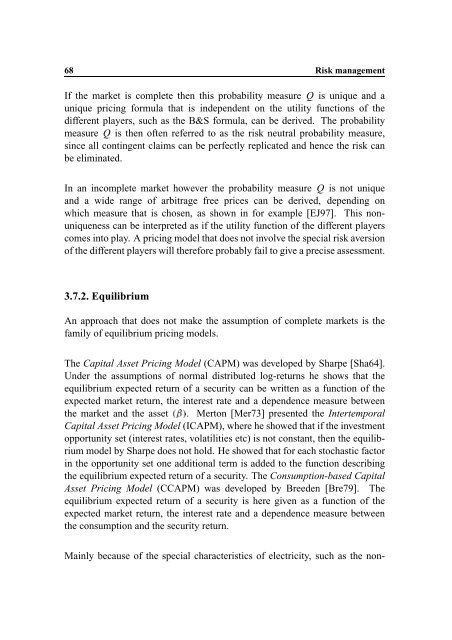Hedging Strategy and Electricity Contract Engineering - IFOR
Hedging Strategy and Electricity Contract Engineering - IFOR
Hedging Strategy and Electricity Contract Engineering - IFOR
You also want an ePaper? Increase the reach of your titles
YUMPU automatically turns print PDFs into web optimized ePapers that Google loves.
68 Risk management<br />
If the market is complete then this probability measure Q is unique <strong>and</strong> a<br />
unique pricing formula that is independent on the utility functions of the<br />
different players, such as the B&S formula, can be derived. The probability<br />
measure Q is then often referred to as the risk neutral probability measure,<br />
since all contingent claims can be perfectly replicated <strong>and</strong> hence the risk can<br />
be eliminated.<br />
In an incomplete market however the probability measure Q is not unique<br />
<strong>and</strong> a wide range of arbitrage free prices can be derived, depending on<br />
which measure that is chosen, as shown in for example [EJ97]. This nonuniqueness<br />
can be interpreted as if the utility function of the different players<br />
comes into play. A pricing model that does not involve the special risk aversion<br />
of the different players will therefore probably fail to give a precise assessment.<br />
3.7.2. Equilibrium<br />
An approach that does not make the assumption of complete markets is the<br />
family of equilibrium pricing models.<br />
The Capital Asset Pricing Model (CAPM) was developed by Sharpe [Sha64].<br />
Under the assumptions of normal distributed log-returns he shows that the<br />
equilibrium expected return of a security can be written as a function of the<br />
expected market return, the interest rate <strong>and</strong> a dependence measure between<br />
the market <strong>and</strong> the SXc V asset . Merton [Mer73] presented the Intertemporal<br />
Capital Asset Pricing Model (ICAPM), where he showed that if the investment<br />
opportunity set (interest rates, volatilities etc) is not constant, then the equilibrium<br />
model by Sharpe does not hold. He showed that for each stochastic factor<br />
in the opportunity set one additional term is added to the function describing<br />
the equilibrium expected return of a security. The Consumption-based Capital<br />
Asset Pricing Model (CCAPM) was developed by Breeden [Bre79]. The<br />
equilibrium expected return of a security is here given as a function of the<br />
expected market return, the interest rate <strong>and</strong> a dependence measure between<br />
the consumption <strong>and</strong> the security return.<br />
Mainly because of the special characteristics of electricity, such as the non-
















